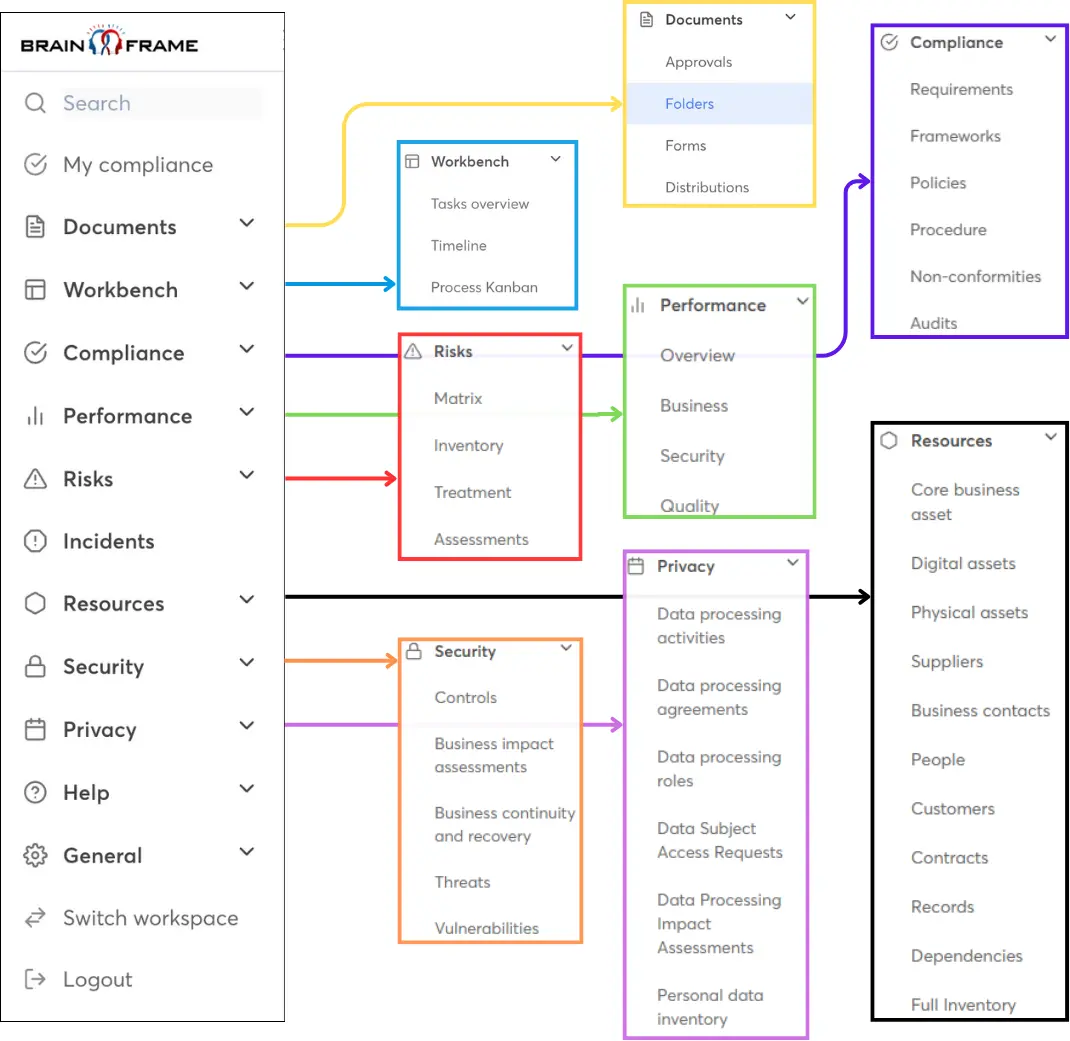Overview
After exploring risk assessment and risk treatment, we now focus on the Statement of Applicability (SOA), a critical document that serves as a cornerstone of any effective Information Security Management System (ISMS). The SOA links risk management activities with the implementation of security controls, tailored to the specific needs of your organization under ISO 27001.
What is the Statement of Applicability (SOA)?
The Statement of Applicability (SOA) is an essential document in an ISMS that details which security controls from ISO 27001 and ISO 27002 are applicable to the organization, providing a rationale for their inclusion or exclusion. It confirms the alignment of these controls with the organization's risk management processes and demonstrates compliance with ISO 27001 standards.
Key Components of the SOA
List of Controls
The SOA includes a comprehensive list of all controls suggested by ISO 27002:2022, clearly stating which controls are adopted. Each control's implementation status is documented along with a justification that aligns with the organization's specific context and identified risk profile.
- Example: Consider the control A.8.24 Use of cryptography, which is concerned with the proper and effective application of cryptographic controls. In the SOA, this control might be categorized as “Applicable and Implemented - Managed or Optimized” if the organization demonstrates an advanced capability in managing cryptographic techniques. This could be evidenced by the establishment of robust procedures for key management, regular reviews of cryptographic relevance against the current threat landscape, and agile responses to advances in cryptanalysis. Justification for this classification could include the organization’s need to protect highly sensitive business data in a sector prone to espionage, thus reflecting a tailored approach to addressing specific operational risks.
Implementation Status of Controls
The SOA describes the implementation status of each control using a detailed rating scale:
- Not applicable: Controls that are not relevant to the organization's operations or risk profile.
- Applicable but not implemented: Controls that are relevant but have not yet been put in place.
- Applicable and being implemented: Controls that are currently in the process of being implemented.
- Applicable and implemented - DEFINED: Controls that are fully implemented and documented.
- Applicable and implemented - MANAGED: Controls that are not only implemented but are also routinely reviewed and managed.
- Applicable and implemented - OPTIMIZED: Controls that are continuously assessed and optimized for performance improvement.
Conducting a Gap Analysis
Before finalizing the SOA, it is crucial to perform a gap analysis to pinpoint where current security controls fall short of the ISO 27001 standards. This analysis helps identify areas that require additional controls or enhancements to existing ones.
Steps in Gap Analysis
Assess Current Controls
Evaluate existing security measures against ISO 27001 controls to determine their adequacy and alignment with organizational needs.
Example: Evaluate the current state of "A.5.24 Information security incident management planning and preparation" to ensure there are comprehensive plans that cover all aspects of incident response, from identification to resolution.
Identify Gaps
Highlight deficiencies where additional controls are needed or where existing ones need upgrading.
Example: If the current incident response plan ("A.5.24") lacks specific procedures for data breach notification, this gap needs to be addressed to comply with legal and regulatory requirements.
Prioritize and Plan
Prioritize gaps based on their risk severity and impact on compliance. Develop an action plan to address these gaps, specifying timelines and responsibilities.
Utilizing Tabletop Exercises for Gap Analysis
Tabletop exercises can be an effective method for identifying gaps in the ISMS. By simulating various security scenarios, stakeholders can visualize the impact of potential threats and assess the effectiveness of existing controls.
Process
Gather key personnel from different departments—such as IT, HR, and Operations—and simulate an incident, such as a data breach or system outage. Discuss the theoretical response according to the current ISMS.
Outcome
These exercises can reveal unseen gaps in procedures and controls, providing a practical perspective on theoretical plans. For example, a simulated phishing attack may expose gaps in user awareness and response procedures, prompting the need for enhanced training and incident management protocols.
Specific Control Examples to Illustrate Gap Analysis and Tabletop Exercises
A.5.1 Policies for information security: Ensure that policies are not only documented but also communicated effectively across the organization. A gap might be found in employee awareness or understanding of these policies, which can be highlighted during tabletop exercises simulating policy breaches.
A.5.28 Collection of evidence: In a tabletop exercise simulating an insider threat scenario, it might become apparent that procedures for evidence collection are inadequate or not followed properly, indicating a significant gap in handling internal security breaches.
A.8.24 Use of cryptography: Assess whether encryption and decryption processes are compliant with legal requirements and are robust against emerging cryptographic attacks. A gap analysis might reveal outdated cryptographic standards being used in critical data protection.
SOA Justification and Risk Linkage
Justifying each control's inclusion in the SOA is critical and must be grounded in the comprehensive risk assessment conducted earlier. This justification ensures that each control is not only necessary but also proportionate to the risks faced.
Criteria for Justification:
- Risk Mitigation: How the control reduces specific identified risks
- Compliance Requirements: The control's role in ensuring compliance with legal, regulatory, or contractual obligations.
- Operational Efficiency: The control’s contribution to maintaining or enhancing business operations.
Continuous Improvement and SOA Review
Regularly reviewing and updating the SOA is essential to ensure that the ISMS adapts to changes in the threat landscape, technological advancements, and business processes. The review process should involve:
- Scheduled Reviews: Establish a regular schedule for reviewing the SOA, typically annually or biannually, to assess the relevance and effectiveness of each control.
- Trigger Events: Implement procedures to trigger additional reviews following significant changes, such as new threat exposures, major technological updates, or organizational restructuring.
- Stakeholder Engagement: Involve various stakeholders in the review process to gain comprehensive insights into the practical aspects of control implementation and challenges.
- Documentation Updates: Ensure that any changes to the control environment or risk landscape are accurately reflected in the SOA, maintaining its status as a living document.
- Performance Optimization: Continuously seek ways to improve the effectiveness of implemented controls, moving from "defined" to "managed" and eventually "optimized" stages.
Questions to Consider
- How effectively are the current controls meeting the organization's security needs?
- What changes or updates are required to enhance the ISMS's responsiveness to new challenges?
- How can stakeholder feedback be integrated into the SOA to enhance security measures?
Conclusion
The Statement of Applicability (SOA) is not merely a compliance document but a dynamic framework that supports the continuous improvement of the Information Security Management System (ISMS). Regular reviews and updates of the SOA are essential to ensure that an organization's security practices not only remain robust and compliant but are also aligned with both current and future requirements. Utilizing a tool like Brainframe can significantly streamline this process. Brainframe offers an intuitive platform that allows organizations to efficiently manage their SOA, ensuring that all changes are documented, all compliance requirements are met, and all improvements are systematically implemented. By integrating Brainframe into your ISMS processes, you can maintain a clear overview of your security controls, making it easier to identify and address areas for enhancement and to prepare comprehensively for internal audits.
Next Step: Bridging the Gap—Key Implementation Steps Before the Internal Audit
With the Statement of Applicability (SOA) now established, the focus shifts to ensuring that the Information Security Management System (ISMS) is fully prepared for the internal audit. This crucial phase involves translating the SOA into actionable steps—implementing and verifying controls, training staff, conducting internal reviews, and addressing any gaps that may exist. The period between finalizing the SOA and undergoing the internal audit is a time to solidify your ISMS, ensuring that it operates effectively and is ready to withstand scrutiny. Let’s explore the key implementation steps that will bridge this gap and set the stage for a successful internal audit.
Resources

Start for free now!
Streamline your GRC work using our all-in-one management solution and get access to our network of local specialists
